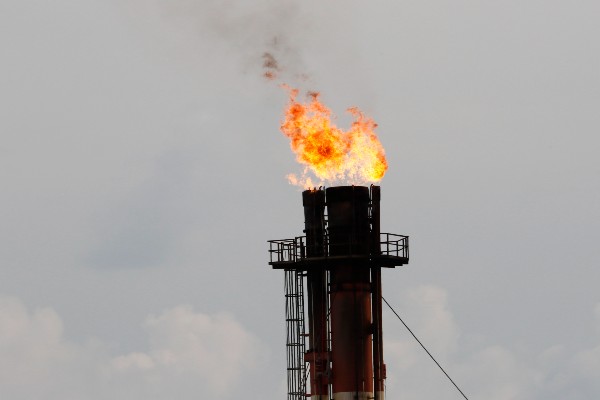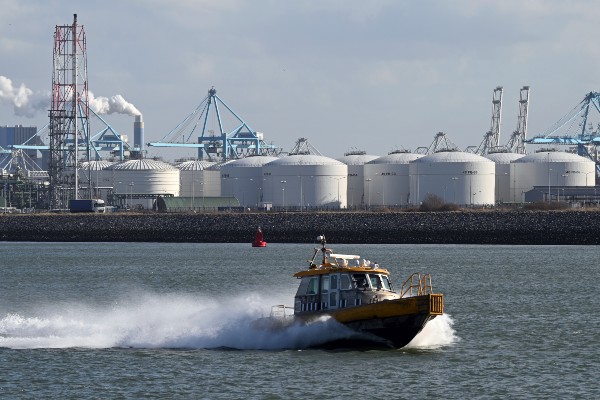
Warmer-than-normal weather in the past few weeks has delayed the start of heating season, cooling gas prices to €98 per megawatt-hour, from €205 only three months ago. This is sparking cautious optimism for navigating the precarious winter ahead.
Last week, the average gas storage filling level among member states was around 96%, a level that covers only 29% of annual consumption in the EU. Countries with low overall storage capacity, such as Belgium or Portugal, have managed to fill their tanks entirely, which has made for positive headlines but only means that they're storing 5-7% of their annual consumption.
We'll probably make it
There's a big caveat to the sea of blue in this map. While most EU member states have gas storage facilities on their territory, a whopping two thirds of total capacity is located in just five countries: Germany, Italy, France, the Netherlands and Austria.
Under new regulation, countries that don't have storage facilities should store 15% of their annual domestic gas consumption in stocks located in other member states, and will thereby have access to gas reserves stored in other member states. This mechanism strengthens the security of EU gas supplies while sharing the financial burden of filling the EU’s storage capacities. Member states with lower storage capacities will collaborate with those owning larger facilities so as to secure their reserves.
“Even considering no flow from Russia, we should be able to get through the winter; at least assuming the current imports from the Netherlands and Norway are not diverted to central Europe and the winter does not turn out to be extremely harsh”, Maurizio Mazziero, financial analyst and commodity expert, says of Italy's situation, for example.
A whole new supplier ecosystem
EU data shows the leading gas supplier in the first half of the year was Norway at 23% of supplies-- or around 50% of Europe’s domestic gas volumes-- followed by Algeria at 11%. The shortfall in Russian gas has mainly been compensated for by a sharp increase in imports of liquified natural gas, particularly from the US.
Between January and August 2022, LNG imports from the US accounted for almost 40 billion cubic meters, almost twice as much as the total figure for 2021. Indeed, the US became the world’s largest exporter of LNG in 2022.
So, let’s say the weather will be mild and Europe gets through this winter with its storage; what about next year? When demand declines, the race to refill starts all over again. Will our new suppliers be ready then?
Speaking at the the Abu Dhabi International Petroleum Exhibition & Conference last week, Claudio Descalzi, CEO of ENI (ENI), said that gas’s price drop in Europe in recent months may not last: Restocking for next year’s winter will be much more difficult. “In 2023 there will be big problems because there will not be any Russian gas. In this context, for instance, it will be essential for Italy to double the flow of gas from Algeria.”
At the same time, it is likely that we’ll see US LNG continue to make its way to Europe, but this doesn't rule out additional supply bottlenecks in the near future. European customers will have to wait a few years for additional supplies to become available, simply because the infrastructure needs time to build.
What to expect next year
While TTF prices are approximately one third of their August peak, upwards momentum has returned. That's despite mild weather, high storage levels and EU policy discussions seeking further measures to mitigate high energy prices.
“We think the market is now looking beyond the mild October to coming winter weather and a still very tight supply picture that could get more so”, says Christopher Louney, commodity strategist at RBC Capital Markets. “While most estimate that Europe will make it through this winter, it will likely be painful and the economic cost of high gas prices on the EU should not be understated. At the very least, today’s natural gas imbalance and demand problems are not disappearing before next winter, and it could be even more challenging year on year if storage is hard to fill.”
As Nord Stream 1 is expected to remain offline following September's explosions, Europe will have to rely heavily on global LNG imports for its immediate energy needs. “Competition for LNG had been intense this summer as countries around the world prepared for winter, leading to further upside risk for spot LNG price,” says Shikha Chaturvedi, Head of Global Natural Gas and Natural Gas Liquids Strategy at J.P. Morgan, in her latest outlook.
Higher prices have also attracted a flotilla of LNG imports to Europe, enabling countries to bolster their natural gas reserves ahead of winter. “Price has done much of the heavy lifting to help refill storage, not only by reducing demand, but also by attracting enough spot LNG cargoes. Northwest European natural gas storage has already surpassed 95% full,” continues Chaturvedi. “The current price weakness seen in the TTF market is likely owing to storage congestion, with the relatively warm start to the winter heating season so far.”
Looking ahead, the energy shortage is expected to persist throughout 2023. “Even if the Northwest European natural gas market exits the winter withdrawal season with 35% in storage, it doesn’t change the fact that Europe will likely have difficulty finding enough new supply to reach 90% full by October 2023,” affirms the strategist. “Further reductions in flows by Russia, particularly through Ukraine, would make storage refill much harder next summer.”
Overall, according to J.P. Morgan research, the TTF price is projected to reach €165/MWh in the first quarter of 2023, €150 in the second quarter, €175 in the third and €190 in the last quarter of next year. “While we expect prices to remain elevated in the second half of 2023 because of Europe’s increasing penetration in the global spot LNG market for supply, we also expect that under normal winter weather this season, price should average lower than is currently reflected by the forward curve in the coming months,” concludes Chaturvedi.
The tough task of ditching TTF
A massive influx of overseas LNG and the throttling of Russian pipeline supplies mean that the TTF no longer reflects supply and demand in international gas markets, according to the EU. With this in mind, the bloc plans to create a new transaction-based benchmark for imported gas. That new benchmark is meant to better reflect LNG supplies through the use of an administrator that gathers transaction data, rather than basing prices on real transactions alone.
The plan is so controversial, even a staffer at EU agency ACER-- the organization tasked with building the new benchmark-- is publicly voicing doubts.
In an interview with the Financial Times, ACER’s head of market data analytics Iztok Zlatar said that “it is a demanding task operationally”, as many LNG deals are bespoke and negotiated privately, and that ACER “cannot tell” if the new benchmark would be accepted by the market.





























